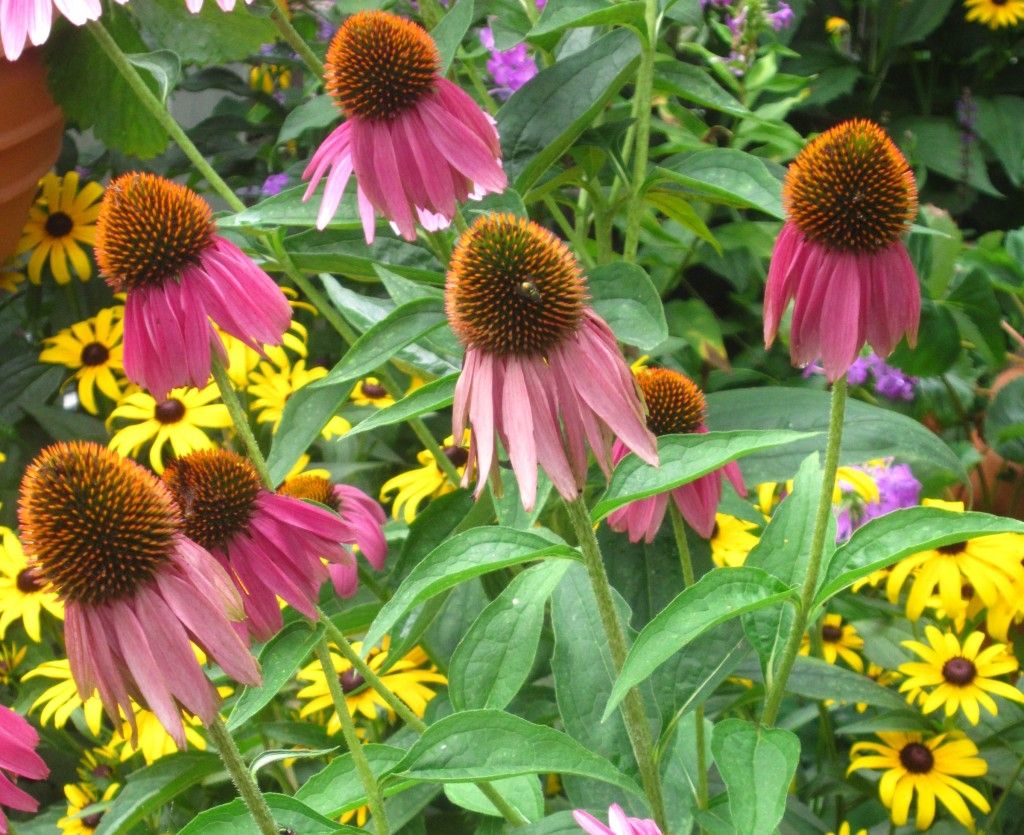Direct sowing is planting seeds directly in the garden bed where you want them to grow rather than starting them indoors first. It’s an easy budget-friendly way to fill gaps and add floral interest to your outdoor space.
Many popular annual flowers like zinnias, marigolds, and sunflowers are commonly direct sown But did you know many perennials can also be successfully direct sown?
Why Direct Sow Perennials
Here are some of the benefits of direct sowing perennial flower seeds
- Less work – No need to start seeds indoors, pot up seedlings, harden off, and transplant outside. Just sow seeds directly into prepared soil.
- No transplant shock – Perennials direct sown in the garden avoid stunting or stunted growth that can happen when seedlings are transplanted.
- Natural spreading – Some perennials self-sow freely. Direct sowing allows them to choose where to pop up and spread naturally year after year.
- Economical – A packet of perennial flower seeds can contain hundreds of seeds for just a few dollars. Much cheaper than buying starter plants.
- Extended bloom times – Successive sowings spaced 2-3 weeks apart provide continuous waves of flowering all season long.
Best Perennials for Direct Sowing
Many popular perennial flowers are great candidates for direct sowing right in the garden bed. Here are some top picks:
Columbine
The spurred, bell-shaped blooms of columbine flowers add charming late spring color. They readily self-sow when direct sown. Sow seeds in fall or early spring. Plants reach 1-3 feet tall.
Coneflower
Coneflowers are daisy-like perennials that attract butterflies and bees. Sow seeds of Purple Coneflower and their hybrids for summer blooms. Deadhead spent flowers to encourage reblooming into fall.
Lupine
Lupine blooms on tall spikes provide cool-toned color. Direct sow seeds of this cottage garden classic in fall. Lupine flowers come in shades of blue, purple, yellow, pink, red, and white.
Poppy
Poppies produce satiny flowers in late spring and early summer. Direct sow Shirley Poppy seeds in fall or early spring for growth from 1-4 feet tall depending on variety.
Yarrow
Yarrow is a tough, herbaceous perennial that can handle dry conditions. Flat-topped flower clusters bloom all summer long. Direct sow this plant with good drainage in spring or fall.
Verbena
Verbena bonariensis is a tall, airy perennial with vivid purple blooms loved by butterflies. Direct sow this unfussy plant in spring for elegant height in the garden.
Foxglove
Foxglove sends up spikes of tubular flowers after its first year. Direct sow seeds of this biennial in late summer or fall for blooms the following year.
How to Direct Sow Perennial Seeds
Follow these simple steps for direct sowing perennial flower seeds successfully:
- Choose a spot – Select a site with suitable sunlight and soil moisture needs for the variety you are planting. Most perennials prefer full sun.
- Prepare soil – Loosen soil and remove weeds if needed. Rake smooth and level the area. Many seeds need light to germinate so avoid burying too deep.
- Sow seeds – Read packet instructions and sow seeds at the recommended depth, spacing, and time of year. Gently press seeds into soil.
- Label – Identify what you planted with markers or garden plan. This prevents weeding out seedlings later.
- Water gently – Water newly sown seeds daily to keep soil moist but not soaked for best germination. A light mist sprayer works well.
- Watch emergence – Check for sprouts. Thin overcrowded seedlings and transplant extras elsewhere if desired.
- Ongoing care – Keep soil moist until plants are established. Weed and replenish mulch as needed.
Reap the Benefits of Perennial Seeds
One of the great joys of gardening is getting a lot of beauty and bounty from a small investment. Direct sowing perennial flower seeds is an easy way to fill your garden with flowers for years to come from just a single packet of seeds.
Give direct sowing a try this season and enjoy continuous color, pollinators, and savings in your garden for many seasons to come.
Hyacinth Bean Vine (Lablab purpureus)
I’ve grown this fast growing vine in containers where the seed germinates faster than you can blink. I liked how it spread out over the pergola posts, but I haven’t needed it on the patio since the wisteria took over. It’s huge and can grow up to 20 feet tall! I saved seeds from the original vines, though, and they’ve done a great job of hiding unsightly parts of my garden. When I planted them in the ground for the first time last summer, they did even better. They quickly spread out over trellises, making a beautiful wall that no one could get through.

Heart-shaped burgundy leaves full of purple veining and sweet-pea like flowers on almost-black stems are eye-catching. Purple pods develop toward the end of the season that are striking in floral arrangements.

How can you look at this happy yellow flower and not smile? It’s my favorite black-eyed Susan. I bought the plants every year at the garden center and was upset that they didn’t grow again very often. I can direct sow them every year if I want them in the garden because they only come back every two years here. And I definitely do! They get about 2. 5′ tall. The dark side of these bright lovelies is that I rarely see pollinators on them.

My garden wouldn’t be my garden without a zinnia, or two, or three. I mean, I LOVE ZINNIAS! The fact that they come in many colors, flower shapes, and heights makes me love them even more. They never disappoint and flower non-stop all summer long. I love picking bouquets of them for the kitchen table. And the picking encourages more flowering so it’s a win-win.
I’m really excited about the Magellan series I discovered while touring Ball Seed Company’s trial garden in West Chicago last summer. At just 12″ tall and sporting 4″ to 5″ color-saturated flowers, Magellans are perfect for edging pathways or adding an upright pop of color to container gardens. I bought a few packets from Park Seed and, at the moment, can’t remember which varieties. It’s late.

As the name suggests, this heirloom vine’s flowers open from cone-shaped buds at night to release their sweet scent. Last summer, my plants had flowers that were 5 to 6 inches across and really shone in their pot on the patio, where a trellis let them climb up the wall and onto the pergola.
Because this and the flowering tobacco bloom in the evening, I think that’s why there are more pollinators in my garden at night. A Polyphemus moth the size of a large man’s hand surprised me in the compost bin last summer.

I used to hate them, until Big Duck walked into my life and made me reconsidered their merits. Not the prettiest smelling flower, I found the colors of the marigolds of my childhood downright ugly. The only thing I liked about them back then was how easily their “heads” came off. My grandmother had them in her garden.
Last summer, All-America Selections sent me Big Duck Gold to try out. You can read about it here. This guy developed huge pompom flowers above lush blue-green foliage. There are some marigolds that I like, but not all of them. I plant mine along the edge of my vegetable garden because that’s where they do best. Some people say they keep rabbits away, but I don’t know for sure. I didn’t have many rabbit problems last year. Perhaps this is why.

Mexican Sunflower (Tithonia rotundifolia)
This is by no means the prettiest plant, it’s actually quite ugly and sprawling. I forgave these shortcomings rather quickly when I realized just how nuts the monarch butterflies were for it. The flower seeds shot up fast and quickly overcame the center of the vegetable garden. It seemed like a good idea at the time but live and learn. At least the butterflies appreciated it. I’ll plant this again in a different part of the garden so it has more freedom, but I can still watch the pollinators from the patio or the window.

6 Easy Flowers To Start From Seed, Direct Sowing Annual Flowers – Sunshine and Flora Flower Farm
FAQ
Can you direct sow perennial seeds?
Can I just throw flower seeds on the ground?
What are the easiest flower seeds to direct sow?
Here we’ve gathered up the easiest flower seeds to direct sow straight into your garden. These foolproof, beginner-level, brown thumb friendly flowering plants are hardy, low-maintenance, and mostly trouble-free, readily establishing themselves in your garden in only a season or two. 1. Columbine ( Aquilegia spp.)
When should you start direct seeding perennial flowers?
April is when temperatures start to heat up, and winter starts to leave. It’s also the perfect month to start direct seeding perennial flowers into your garden beds. In this article, gardening expert Jill Drago shares her favorite perennial flowers you can direct seed into your garden during the month of April!
Can you direct sow flowers in a container?
But direct sowing, whether in the ground or a container, is about as budget friendly as gardening gets. And an endless supply of flowers is the icing on the cake! Loading Some flower seeds are a piece of cake to direct sow in containers or the garden. They’re also incredibly easy on the budget, giving more than they take.
How long does it take to grow perennial flowers from seed?
True, they often take a year to become established and start blooming, but there are ways around that. And starting perennial flowers from seed is a great way to fill out your garden without breaking your budget. Here are 10 perennials that are easily grown from seed and some tips for starting each.
- The Ultimate Guide to Growing Strawberries in Raised Beds - August 8, 2025
- No-Dig Garden Beds: The Easiest Way to Grow a Beautiful Garden - August 6, 2025
- How to Protect and Preserve Wood for Raised Garden Beds - August 6, 2025

